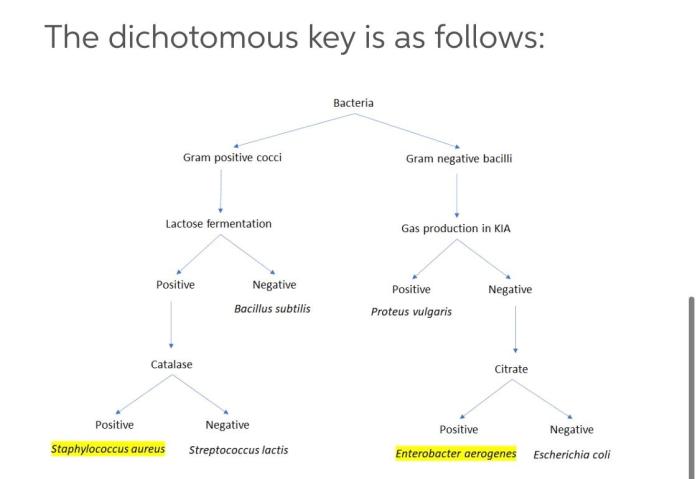Dichotomous key for unknown bacteria – Dichotomous keys, indispensable tools in the field of bacteriology, provide a systematic approach to identifying unknown bacterial species. These keys, constructed using contrasting characteristics, guide users through a series of binary choices, ultimately leading to the identification of the target organism.
The principles of dichotomous key construction involve selecting informative characteristics that effectively differentiate between organisms. These keys are widely used in practical settings, enabling researchers and practitioners to identify unknown bacteria efficiently.
1. Introduction to Dichotomous Key

A dichotomous key is a tool used for identifying unknown organisms by dividing them into two contrasting groups based on specific characteristics. It is a series of paired statements or questions that guide the user through a logical decision-making process, ultimately leading to the identification of the unknown organism.
Dichotomous keys are particularly valuable in the field of microbiology for identifying unknown bacteria. They provide a structured and efficient approach to classifying bacteria based on their observable characteristics, such as morphology, staining properties, and biochemical reactions.
2. Principles of Dichotomous Key Construction, Dichotomous key for unknown bacteria
The construction of a dichotomous key involves the following principles:
- Contrasting characteristics:Each pair of statements or questions in the key presents contrasting characteristics. For example, “Gram-positive” versus “Gram-negative” or “motile” versus “non-motile”.
- Logical sequence:The characteristics are arranged in a logical sequence, starting with the most general and progressing to the more specific.
- Clarity and precision:The statements or questions should be clear, concise, and unambiguous.
3. Applications of Dichotomous Key in Bacteria Identification
Dichotomous keys play a crucial role in identifying unknown bacteria. They offer several advantages:
- Efficiency:They provide a systematic and efficient approach to identifying bacteria, eliminating the need for extensive testing.
- Objectivity:They minimize subjectivity by relying on observable characteristics rather than subjective interpretations.
- Standardization:They allow for standardized identification across different laboratories and researchers.
4. Design Considerations for Dichotomous Key
When designing a dichotomous key, it is important to consider the following factors:
- Target audience:The key should be designed with the intended users in mind, considering their level of expertise and knowledge.
- Selection of characteristics:The characteristics used should be informative, easy to observe, and relevant to the identification of the target organisms.
- Organization of characteristics:The characteristics should be organized in a logical sequence, starting with the most general and progressing to the more specific.
5. Advanced Techniques in Dichotomous Key Development
Advanced techniques can be employed to optimize dichotomous key development, including:
- Statistical analysis:Statistical methods can be used to determine the most informative characteristics for key construction.
- Artificial intelligence:Artificial intelligence algorithms can be applied to optimize the structure and accuracy of dichotomous keys.
Quick FAQs: Dichotomous Key For Unknown Bacteria
What is the purpose of a dichotomous key?
A dichotomous key is a tool used to identify unknown organisms by presenting a series of binary choices based on contrasting characteristics.
How are dichotomous keys constructed?
Dichotomous keys are constructed using contrasting characteristics that effectively differentiate between organisms.
What are the advantages of using dichotomous keys?
Dichotomous keys provide a structured and efficient approach to identifying unknown organisms, making them particularly useful in fields such as microbiology and taxonomy.

